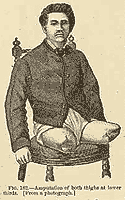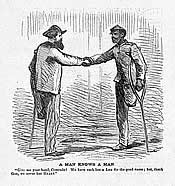
|
Study Questions for Part Three 1. Search the periodical literature of the nineteenth century for articles
on masculinity, femininity, and their variants. You might try working
with the Making
of America electronic database, which should help facilitate your
search for these terms. If your library has nineteenth-century periodicals
in their holdings (e.g., Godey's Ladies Book, Harper's,
Atlantic Monthly, etc.), spend some time perusing them. Though
these periodicals are not as easily searchable as those on a database,
there is no better way to attain a sense of nineteenth-century material
culture in all its multiplicity. For example, consider J.D.
Bell's "Manliness" which appeared in the July 1859 issue
of the Ladies' Repository.
3. Whitman published the Calamus cluster of poems in 1860-1
edition of Leaves of Grass. How do his representations of relations
between men in this cluster compare with those that appear in Drum-Taps?
Remember that the two clusters span the Civil War. |
|||

